If you’re health and weight conscious, you’re no stranger to the bathroom scale. But where in your home do you keep your Ludwig Scale.
scale. But where in your home do you keep your Ludwig Scale.
Aha, you don’t, because as something to stand on or measure anything concrete, there’s no such thing. Nonetheless, the Ludwig Scale is very real and the most accurate way to determine the extent o! female baldness.
The scale is widely used to identify the severity of hair loss and to determine the best course of action. The basis of the Ludwig Scale is that there are three types of female pattern baldness, with type 1 indicating initial signs of balding and type 3 representing the most severe cases. While it’s helpful in identifying potential signs of female pattern baldness, you’ll want to meet with the medical team at DiStefano Hair Restoration Center to obtain a more accurate and complete analysis.
Type 1 Hair Loss
Type 1 is represented by a thinning crown or thinning at the top of the head. Some women notice a slight widening of the hair part. In general, this stage can be difficult to notice because unlike men, women don’t lose hair at the front of their heads.
Type 2
During a Type 2 phase, more scalp is starting to show with significant hair loss on the top of the head or crown. This is considered moderate hair loss. Hair will start to look and feel thinner, and you may notice increased shedding as well. Hair may not style the way it used to as it loses volume. You may also notice a more prominent widening of your hair part.
Type 3
The most severe type of hair loss, Type 3 is signified by hair that is so thin it no longer fully conceals the scalp.
Signs of Balding
The good news is that female hair loss is not as common; more women will experience hair thinning vs. total loss. The same cannot be said of men. Noticing the first signs of hair loss is crucial to preventing a worsening of the problem. Consult your healthcare professional if you notice any of the following early signs of balding:
- An increase in hair on your pillow, hairbrush, or on the shower floor after a shampoo
- Widening of the hair part
- Overall thinning and loss of volume
- Bald spots that are patchy or circular
While hair loss can be hereditary, some women experience temporary thinning or loss due to a physical or emotional trauma, illness or medications, hormonal changes, and more.
Receding Hairline
While not as common in women as men, a receding hairline (bitemporal recession) can occur due to genetics or an underlying health condition. There are a variety of treatment options for help restore the hairline.
Traction Alopecia is a type of hair loss associated with repeated stress on the scalp from harsh styling techniques or consistently tight hairstyles that cause stress and damage to the hair follicles. Consider changing your hair care and styling routine, avoiding tight ponytails and rough brushing.
If you’re a woman experiencing hair loss, where do you think you fit on the Ludwig Scale? Wherever that might be, don’t lose another minute before contacting DiStefano Hair Restoration Center for a free consultation. We’re here to make you proud to display your hair – every last strand – at work, home, or play.


